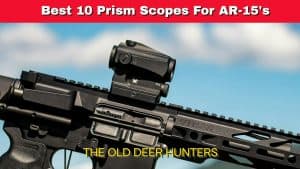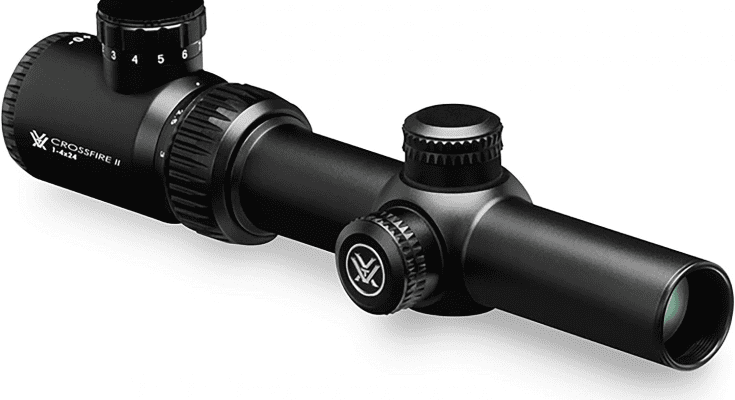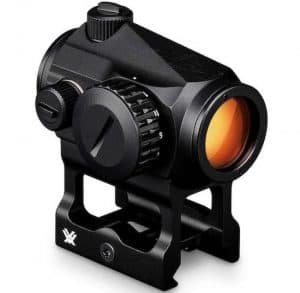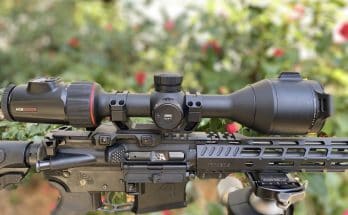The Colt HBAR II AR-15 (officially dubbed the Colt Match Target Competition HBAR II)- My rifle is a Colt Match Target (flat top) with 16″ heavy barrel with 1 in 9 twist. A 20″ heavy barrel version is also available. It has a removable handle so that a scope or optical site can be easily mounted. It comes with match rear sights and post front site.
The Colt Match Target Competition HBAR II AR-15 is a factory produced match AR type rifle. Designed with competitive shooting and precision in mind, this rifle offers precision accuracy.

My eyes are not what they used to be so I first opted for a Trijicon ACOG Reflex optical sight. This sight is great for general use. You can order it with a mount for either version of the AR-15. The sight is the “dot” type reticle, not a cross hair and it has no magnification. My sight has a 7 minute of angle orange dot, but can now be purchased with a 3 MOA dot for more precise aiming. A tritium lamp powers the dot in low light conditions, with no batteries required, and it has no off/on switch like most dot sights During day light, the dot is power by fiber optics absorbing the surrounding light.
After a couple of trips to the range, I couldn’t help but wondering how accurate the HBAR II was, so I decided to mount a scope on the rifle for some target work. I mounted a Leupold VXIII 3.5×10 for accuracy testing.
On the first trip to the range I was hoping for one MOA groups or 1″ at a 100 yards. After a few zero shots to get on target, I tried a load that shot well in my Kimber M84 bolt action. I could not believe what was happening on the next few shots. The AR15 was shooting under one inch for the first five shots!!! This was an off the rack rifle right out of the box.
The hard part of shooting the rifle accurately was dealing with the heavy service match trigger. It broke pretty cleanly, but in 4-6lb range. Needless to say, I had to work on the trigger. I looked around the Internet and talked to a few people and decided to replace the factory trigger assembly with one made by JP Enterprises.
I installed it myself with the excellent instructions provided with the trigger. Took about an hour or so. The JPE trigger is completely adjustable, takes all the creep out and breaks like glass. I set it to fire with about 3 lb. of pull. Now back to the range for the next round of tests. The new trigger now lets me consistently shoot 1/2 MOA groups with handloads or match ammo.
On a recent prairie dog hunt, MR. President couldn’t believe how the Colt Match Target Competition HBAR II would reach out there with the heavy barreled varmint rifles in the 250-300 yard range. One great thing that we noticed on the prairie dog hunt is that the recoil is so light, the scope doesn’t move off the target. You see the bullet hit the target through the scope.
I may not be able to shoot those groups on my next trip to the range, but I now have total confidence in that rifle. I will trust it on the next hunt and I will trust it if I ever have to defend myself with it.
It is more accurate than I am, and after shooting approximately 2000 rounds of different types of ammo, both factory and handloads, it has never misfired or jammed.

Best Selling 3x Prism Scopes for Your AR-15 Under $400
Colt Match Target Competition HBAR II History
The Colt Match Target Competition HBAR II AR15 has its roots in the evolution of the AR-15 platform and Colt’s long history of producing firearms. Here’s a brief overview of the history that led to the development of this rifle:
1. Origins of the AR-15: The AR-15 platform traces its origins back to the 1950s when engineer Eugene Stoner developed the Armalite AR-15 rifle. The design featured lightweight materials and innovative features, including the use of gas impingement for operation. The rifle was initially marketed to military forces around the world.
2. Military Adoption and Colt’s Role: The military variant of the AR-15 was adopted by the U.S. military as the M16 rifle during the 1960s. Colt, a prominent firearms manufacturer, became one of the primary producers of the M16 for the military. The M16’s design evolved over the years to suit military requirements.
3. The Sporting Market: As the AR-15 gained popularity in military circles, its civilian counterpart, the Colt AR-15, found its way into the civilian sporting market. Colt recognized the potential of this platform for civilian shooters and began producing variations of the AR-15 for civilian use.
4. Competition Shooting and Precision: During the 1980s and beyond, competitive shooting, particularly in disciplines like Service Rifle and High Power Rifle, gained traction. Shooters were looking for rifles that combined accuracy and reliability. Colt responded by developing the Colt Match Target series, which was tailored to the needs of competitive shooters. The “HBAR” (Heavy Barrel) variant was specifically designed to enhance accuracy by reducing barrel movement and heat buildup during extended shooting sessions.
5. Evolution of the HBAR II: The Colt Match Target Competition HBAR II AR-15 represents a refinement of Colt’s earlier Match Target offerings. It incorporates feedback from competitive shooters, advancements in rifle technology, and a focus on accuracy. The heavy barrel, match-grade trigger, and other features make it well-suited for precision shooting events.
6. Impact and Legacy: The Colt Match Target Competition HBAR II AR-15, along with its predecessors, has left a lasting impact on the competitive shooting community. It has become a trusted choice for marksmen who value accuracy and consistency in their rifles. The rifle’s success can be attributed to Colt’s commitment to quality and its responsiveness to the needs of shooters.
7. Industry Influence: The success of the Colt Match Target series contributed to the broader trend of AR-15 platform rifles becoming popular choices for various shooting applications. The modular design of the AR-15, its customization options, and its adaptable nature have made it a versatile firearm in the hands of civilian shooters, law enforcement, and military personnel.
In conclusion, the history of the Colt Match Target Competition HBAR II AR-15 is intertwined with the development and evolution of the AR-15 platform, which has become a symbol of versatility and performance in the firearms world. This rifle stands as a testament to Colt’s dedication to meeting the needs of precision shooters and contributing to the ongoing legacy of the AR-15 design.
Best AR15 Scopes Under $200

Best AR15 Scopes Under $200 by The Old Deer Hunters – Welcome to our comprehensive review of the top AR15 Scopes under $200! We will explore and analyze the features and performance of some popular models, including Bushnell Optics, Vortex Optics, Primary Arms Optics, Sightmark Optics, Sig Sauer an Burris Optics. The list includes hunting scopes, tactical scopes and red dot sights that are tailor-made for the AR15 Rifle. Some of these AR15 optics are for close quarters and personal defense, while others are better suited for hunting and plinking. See the Best AR15 Scopes Under $200.

Best Red Dot Sights for AR-15s Under $200
Colt Match Target Competition HBAR II Specifications
Caliber: The Colt Match Target Competition HBAR II AR15 is chambered in .223 Remington/5.56x45mm NATO, a versatile and widely available cartridge ideal for both target shooting and tactical applications.
Barrel Length: The rifle features a 16 or 20-inch heavy barrel (HBAR) that enhances accuracy by reducing barrel whip and heat buildup during sustained firing. The extended length also provides a longer sight radius for improved aiming precision.
Barrel Profile: The heavy barrel profile contributes to the rifle’s stability and accuracy by minimizing barrel vibration and increasing rigidity. This is particularly advantageous for precision shooting.
Twist Rate: The barrel features a 1:9 twist rate, optimized for stabilizing a wide range of bullet weights, including heavier projectiles commonly used in competitive shooting and long-range accuracy.
Upper and Lower Receivers: The Colt Match Target Competition HBAR II AR-15 utilizes forged aluminum upper and lower receivers, providing a solid foundation for the rifle while keeping weight manageable.
Handguard: The rifle features a free-floating handguard as required for Service Matches.
Gas System: It employs a direct impingement gas system, a design that is reliable and has been a staple of AR-platform rifles. The adjustable gas block allows shooters to fine-tune the rifle’s gas operation for optimal performance.
Trigger: The rifle comes with a single-stage, match-grade trigger that enhances accuracy by providing a clean and consistent trigger pull. The trigger weight is also set at Service Match weight.
Furniture: The Colt Match Target Competition HBAR II AR-15 comes with a fixed A2-style stock and a standard A2 pistol grip. These features are designed to offer a comfortable shooting experience while maintaining a classic appearance.
Sights: The rifle is a flat top design with removable carry handle that houses a match rear sight and standard post front sight. This allows shooters to choose iron sights or optics that suit their shooting preferences and competition requirements.
Overall Length: With a 20-inch barrel, the rifle has an overall length of approximately 39 inches, striking a balance between maneuverability and accuracy.
The Colt Match Target Competition HBAR II AR-15 is a precision rifle built for shooters who demand exceptional accuracy and reliability. With its heavy barrel, high-quality trigger, and match-grade components, this rifle is designed to excel in competitive shooting scenarios.
Its robust construction, thoughtful design, and compatibility with a wide range of accessories make it a platform that can be customized to suit individual preferences and competition requirements. Whether you are a casual shooter or a dedicated marksman, the Colt Match Target Competition HBAR II AR-15 offers the tools needed to achieve outstanding accuracy on the range.

6.5 Grendel Hog Hunting Rifle
Best AR-15 Scope Under $100
Aero Precision AR-15 Upper Receiver 223 Review
Faxon AR-15 Barrel – 6.5 Grendel
Best Biometric Rifle Safe – Fingerprint Access
300 Blackout Range Test



